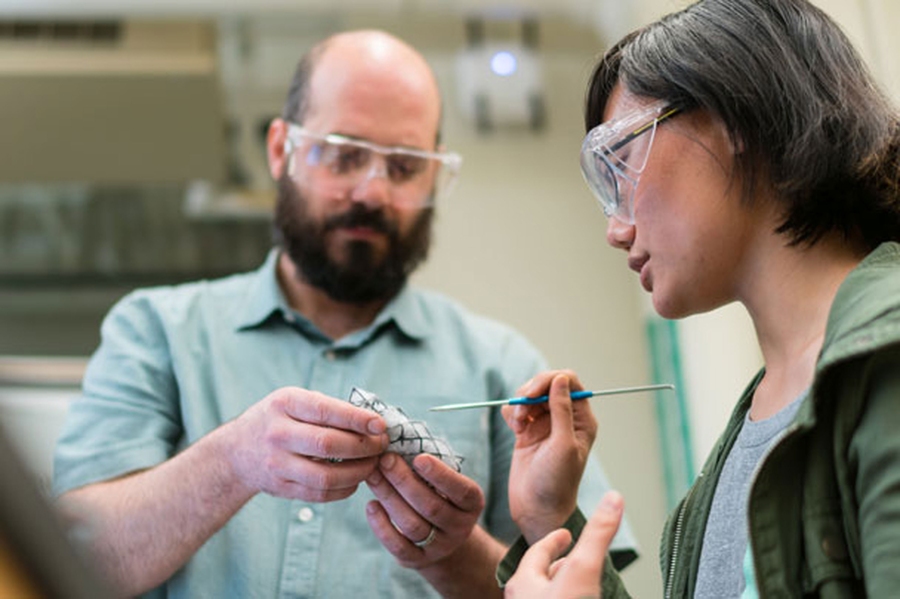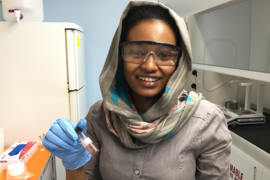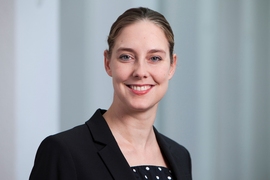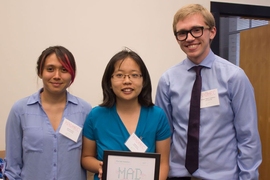Felipe de Quesada is cut out to be a materials scientist. He likes to design things and see how they work at a microscale: to look at the arrangement of atoms and study their crystal structure. This fascination traces back to boyhood when he created his own toys.
“I encountered a lot of problems that involved materials. One time I created a U-boat out of styrofoam. It took three months and it was beautiful — until I used a spray can to paint it black,” says de Quesada, a junior majoring in Course 3. “I didn’t know anything about thermodynamics back then. It crumbled the whole project,” he says. “That was a moment of frustration, but it got me extremely interested in materials.”
Today de Quesada is surrounded by peers who share his curiosity. He and 16 other third-year students worked in teams this spring to develop materials in 3.042 (The Materials Project Laboratory), the capstone design course for undergraduate students in materials science and engineering. His project involved working on a cobalt-free high-entropy alloy.
What you don't know, you don't know
All four of the student teams this semester assigned themselves steep challenges, says Michael J. Tarkanian, the lead instructor for the course. And that’s the whole point. “We want them to work as a team and design experiments and make informed decisions following the scientific method.” He says de Quesada’s team succeeded in making their alloys, characterizing them, and working to improve their properties, all of which, Tarkanian notes, is “a monumental amount to accomplish in three months.”
Students learn quickly that 3.042 has a core principle: Do not sugarcoat your answers or inflate your results. “We want our students to learn to be honest about what they have achieved and what is left to do,” Tarkanian says. “I tell them you're not going to finish a project in a single semester. We allow people to be okay with not having all the answers. We try to convince them they can't have all the answers, in any field, without huge amounts of experience, ever.”
Like many of his classmates, de Quesada absorbed this lesson. “There were many times we didn't find the solution we wanted. So we had to come up with methods drawing from what we've learned in classes and try to connect the dots. The course teaches us to work together, to manage problems, and to be creative on a strict timescale.”
Showtime
The camaraderie on display during 3.042 final presentations in May is both particular to the course and, according to students, the Course 3 major itself, which includes about 40 students per class year. Other students slipped in and out of the classroom to take in their peers’ work and give thumbs up.
“All the students in Course 3 are super-supportive of each other. We are like family,” says Mindy Wu, a third-year student who presented on synthetic goose down, specifically on maximizing thermal insulation and mechanical resilience. The team goal was to mimic the lofted insulation and mechanical resilience of goose down by creating an ordered packing structure.
“The goose down project was more challenging than even the instructors expected,” Tarkanian admits. “A lot of their development was trying to achieve something that nature has solved in a really elegant way that maybe isn't so easy to synthesize. I think they did a great job.”
Kaitlyn Mullin, also a third-year student, worked on electroactive variable-focus liquid lenses. “Going into the presentation, we felt like we’d done everything we could. We had a pretty good theoretical understanding of everything and a logic behind our decisions. And if something failed, why that happened,” she says. The team goal was to create a lens that matches industry performance. Mullin is considering keeping on with the work as a senior thesis.
The fourth team project on designing a recyclable arsenic extraction system is also a strong candidate for future thesis work, says Tarkanian. “I’ve seen students in some semesters start slow and ramp up and end up in the lab 24 hours a day at the end,” he says. “These guys never slowed down. Everyone runs out of time. No one is ever done. And what they accomplished was great.”









